There’s no doubt that the amazing beauty and unique fragrance of the genus dianthus make it a perfect choice for gardens and raised flowerbeds!
Imagine walking through a garden and getting a subtle sweet but spicy scent that is similar to cinnamon and cloves. You find whatever flower might be putting off such a unique scent, and see the jagged edges of beautiful, light pink flowers. Those flowers would be dianthus, also referred to as sweet william or pink.
While you might assume that the flower received the “pink” name from the color of its blooms, that actually isn’t the case.
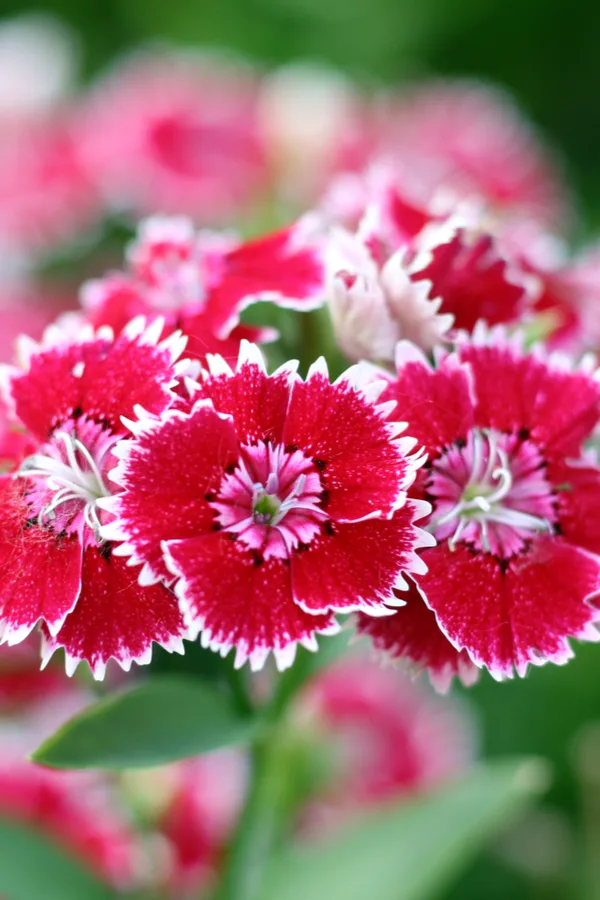
The name refers instead to the jagged petal edges that give this flower its unique appearance (similar to the edges that pinking shears produce when cutting fabric). Often known to be a favorite for cottage gardens and along garden borders, dianthus looks stunning anywhere it is grown.
In addition, these beautiful plants also happen to be deer resistant. And that can be a huge plus for those looking to plant a less desirable landscape to keep pesky animals away! See: 7 Great Deer Resistant Perennials Plants
Varieties of Dianthus – The Amazing Beauty of Dianthus
There are over 300 different varieties of the genus dianthus. They are available as hardy annuals, biennials, and perennials, so there is definitely a variety to fit your gardening style. Flowers can range in size from 6 inches to around 24 inches tall, and around the same width as well.
Not all varieties put off the unique spicy scent. Carnations are a well-known and popular variety of dianthus that instead offer a sweeter scent. It’s very likely that you’ve seen carnations featured in flower bouquets, table displays, or even boutonnieres. In fact, most dianthus flowers make excellent cut flowers.
Their foliage is made up of thin, long blue-green leaves with narrow stems. The blooms are made up of petals in solid and variegated shades of red, pink, white, and even purple. Blooms can be either single or double, but they all feature the jagged edges that make this flower so stunning.
The hardiness of Dianthus will vary depending on the species, but most are perfect for Growing Zones 3-9. Most varieties bloom in late spring. Then, if they are deadheaded properly, they will produce another beautiful show of blooms in the fall, making them a beautiful choice for long-season displays.
The Amazing Beauty of Dianthus – How To Plant, Grow, And Maintain Dianthus With Ease
Dianthus flowers thrive in raised beds and container gardens as well as in traditional flowerbeds. Their plentiful blooms are great for attracting bees, butterflies, hummingbirds, and other pollinators to your property.
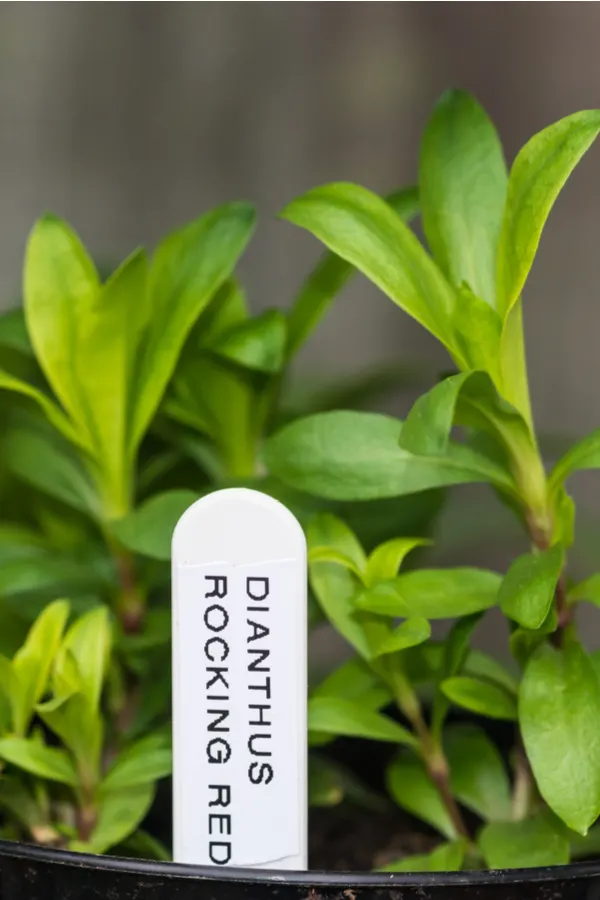
The majority of dianthus flowers are very easy to grow and require little maintenance. As long as they have ample amounts of sunlight, proper soil drainage, and a little bit of deadheading, these flowers will put forth a beautiful and stunning display of blooms twice a year.
Soil Requirements for Dianthus
Dianthus flowers require soil that is well-draining since their roots can be susceptible to root rot if left in standing water. Amend heavier soils such as clay with several inches of compost and other organic matter prior to planting to help with drainage. Aim for neutral to slightly acidic soil with a pH of 6.0 to 7.5.
Planting Dianthus – The Amazing Beauty of Dianthus
These heavy bloomers can be directly sown, grown as transplants, or started from seeds indoors. If temperatures drop below 40º Fahrenheit (4º Celsius), cover plants with a light sheet to protect them.
Starting Seeds Indoors
To grow dianthus flowers from seed, you need to start them indoors about 6 to 8 weeks before your Last Spring Frost Date. Fill your containers with pre-moistened seed starting soil. Place a couple of seeds spaced evenly apart in each cell. Cover lightly with soil.
Seeds should germinate in about 8 to 10 days for most varieties. Keep soil moist. Thin plants after they have one or two sets of true leaves. Once plants have reached around 4 inches tall, they are ready to be transferred outside as long as the threat of frost is gone.
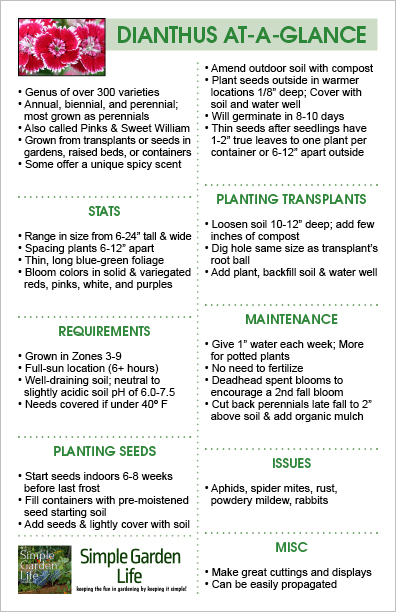
Planting Transplants
Choose a location that receives at least 6 hours of sun or more. You can plant dianthus in a location that has partial shade, but their blooms will be less plentiful and vibrant.
Loosen the soil around the planting location about 10 to 12 inches deep, mixing in a few inches of compost. Dig a hole that is the same depth as the roots of the dianthus transplant and place the plant inside. Space plants about 6 to 12 inches apart (spacing will depend on variety).
Back fill the soil and water the plants in well. Plant dianthus flowers in containers following the same steps above.
Direct Sowing Outdoors
For direct sowing in warmer locations, loosen soil and add a few inches of compost. Plant seeds about an eighth of an inch deep and cover lightly with soil. Water to help set seeds and encourage germination. Once seedlings have one or two sets of true leaves, thin so plants are 6 to 12 inches apart (spacing will depend on variety).
Long-Term Care – The Amazing Beauty of Dianthus
Watering
Dianthus flowers need about one inch of either rainwater or hand watering each week. Avoid standing water if at all possible, even allowing the soil to dry slightly between watering. Make sure to water flowers early in the morning or in the evening. When watering, do so at the base of the plant as opposed to overhead.
Keep in mind that dianthus flowers that are growing in containers will need watering more often than those growing directly in the ground.
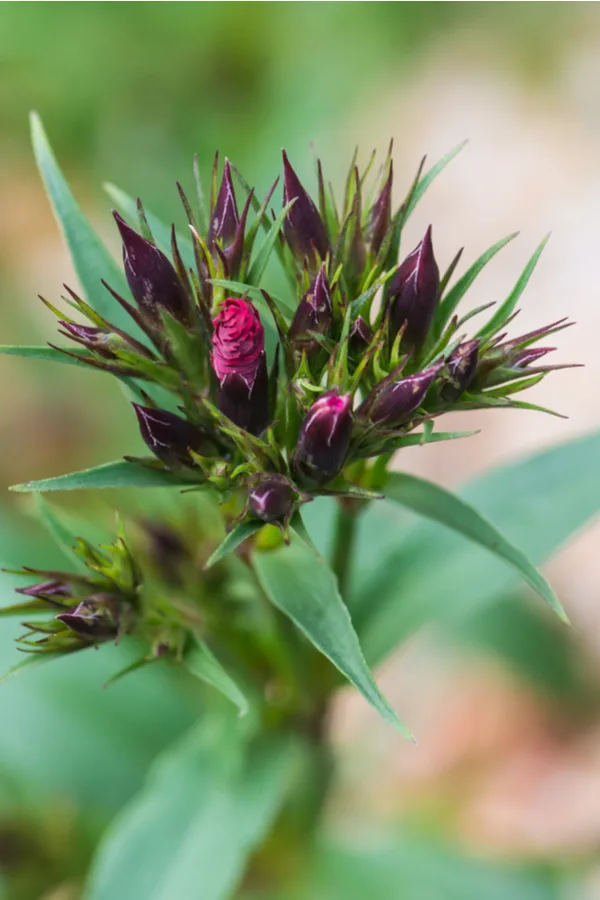
Mulching – The Amazing Beauty of Dianthus
There really isn’t a need to add mulch during the growing season unless you want to help suppress weeds. However, for perennials, you will want to add mulch after you have cut back plants to help protect their roots from the harsh winter weather (more on this below).
For more tips on keeping your flowers weed-free in addition to using mulch, check out our podcast, “How To Keep Your Flowerbeds Weed Free All Summer Long.”
Fertilizing
Even though dianthus flowers are heavy bloomers, they aren’t heavy feeders. The addition of compost when planting is likely all of the fertilizer that dianthus flowers need to get them through a growing season.
You can add a dose of all-purpose liquid fertilizer before fall blooming if preferred. Compost tea is an excellent all-natural liquid fertilizer to use.
Deadheading & Pruning – The Amazing Beauty of Dianthus
For varieties that can bloom twice a growing season, deadheading will help encourage a better second bloom. Simply snip off a spent bloom with sharp gardening shears. Also, remove any foliage or stems that might appear damaged. This will help to keep plants tidy and in better health, especially with perennial varieties.
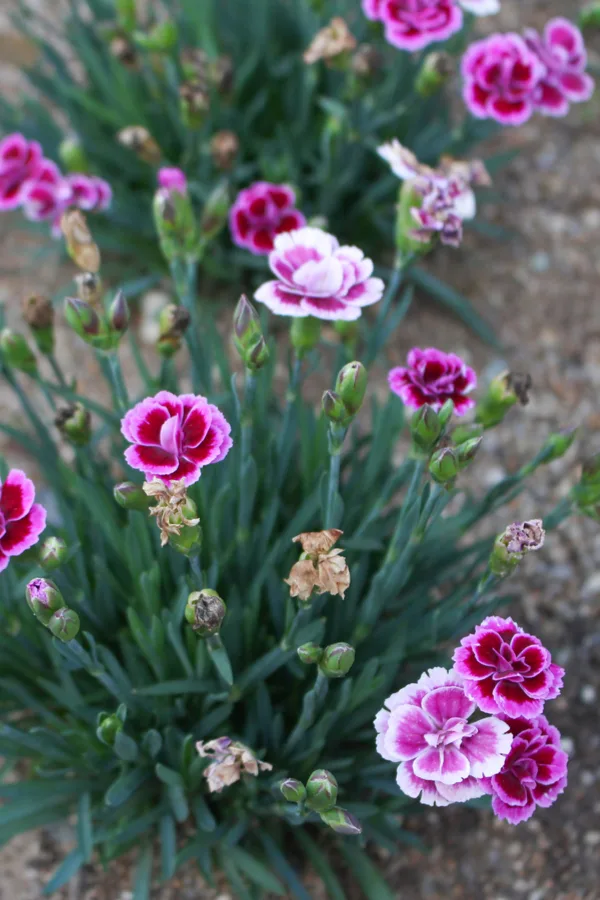
For perennials, you need to cut the stems back to about 2 inches above the ground in late fall, doing this after plants are done blooming for the second time. Be sure to add several inches of organic mulch such as shredded leaves, grass clipping, or straw to help protect plants during the winter months.
Remove most of the mulch in the spring once the threat of frost has passed. This will allow air and light to warm the soil and speed growth.
Pests & Issues
Most dianthus flowers are fairly disease-resistant, especially newer varieties. Rust and powdery mildew are two of the most common issues that can be avoided with proper spacing and watering of plants.
Although dianthus flowers are deer resistant, rabbits love to nibble on them. Consider planting an alternative flower in locations where rabbits are an issue. In addition, typical plant pests such as aphids and spider mites can also be an issue as well.
Propagating – The Amazing Beauty of Dianthus
You can easily propagate perennial dianthus flowers using stem cuttings from an established plant that is at least one season old. After the plant has finished blooming in the middle of summer, take a 3- to 4-inch section off of a non-flowering stem, just below a leaf joint.
Remove any extra leaves. Dip the end of the cutting into a hormone rooting mixture and place it in a container filled with pre-moistened potting soil. Put the container in a sunny and warm location.
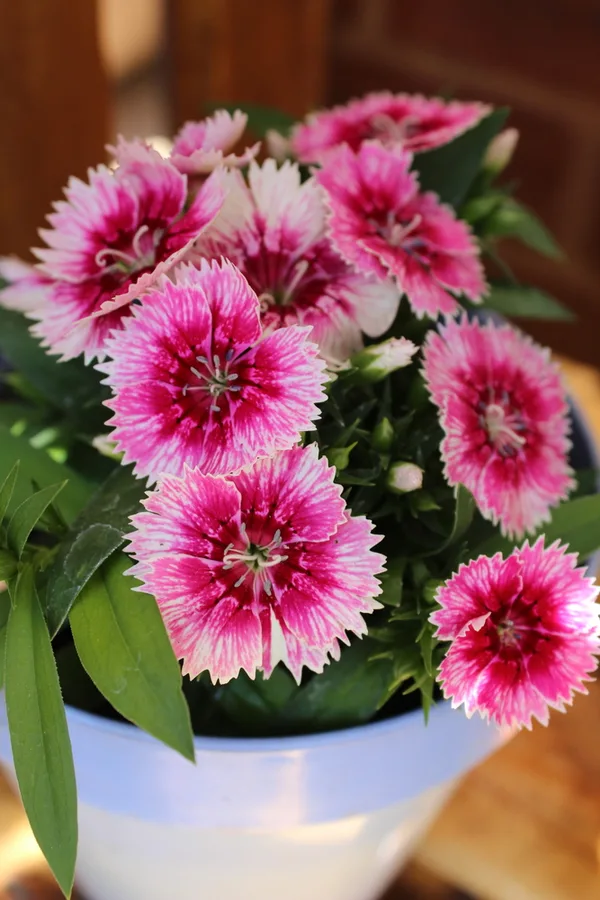
Keep the soil moist but not saturated. The cutting should start to take root in about a month. After you begin to see leaves growing from the cutting, it is time to transplant.
To Conclude…
If you are on the hunt for a timeless flower that can provide you with two seasons of blooms, then dianthus flowers are definitely the plant for you. Their beauty and ability to grow in multiple locations along with their ease of care makes dianthus one amazing addition to any home garden!
Feel free to download, print out, or save the above Dianthus At-A-Glance sheet. It is sized for half letter printing but can be scaled if needed.
Follow Our Facebook Page For Even More Great Tips! Simple Garden Life Facebook Page
Simple Garden Life is a website dedicated to keeping gardening fun, simple and enjoyable! We publish two new articles each week along with a new garden podcast episode every two weeks. This article may contain affiliate links.
